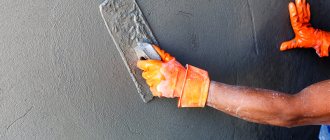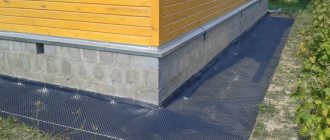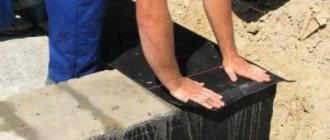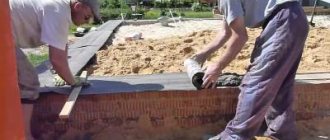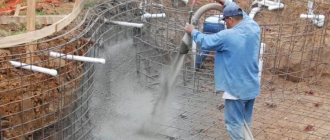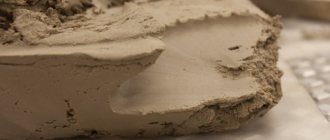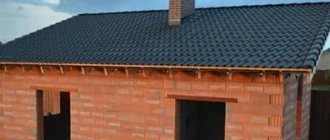Floor waterproofing with liquid glass is a type of penetrating insulation. It is obtained industrially from an aqueous solution of sodium silicate. Fine quartz sand is mixed with soda and fired in a kiln.
This is practically the only material that can be used to cover the base at high humidity; it is used in residential and industrial premises, swimming pools, baths, and saunas. Suitable for protecting wooden surfaces from moisture and protecting the material from fungal infections.
Functions of liquid glass
Liquid glass (silicate glue) is an alkaline solution of silicate salts. It is made from silicon-containing material calcined at a temperature of 500-600 degrees for 15 minutes.
After this, the substance is treated with an alkaline 5-10% solution at a temperature of 90-95 degrees. As a result of the reaction, the finished substance is released.
When the material hardens, it forms an impermeable layer, which is a reliable barrier to moisture penetration.
- repels water;
- prevents the appearance of fungi and bacteria;
- protects the surface from destruction when exposed to acids and other abrasive substances;
- liquid glass coating for the floor is not electrified and does not attract static;
- does not burn, does not support combustion.
It is often used for waterproofing the walls of wells and tanks when laying stoves and fireplaces.
In construction it is used in a diluted state in the form of powder with water. The finished solution has a viscous consistency that hardens very quickly.
Tools
0 votes
+
Vote for!
—
Vote against!
Among the large number of options for waterproofing, liquid glass stands out with many advantages. We will consider the features, application and characteristics of this material further.
Table of contents:
- General concept and advantages of liquid glass
- Scope of use and types of liquid glass
- Recommendations for working with liquid glass
- Liquid glass - operating instructions and application
- Liquid glass for waterproofing - nuances in application
- Recommendations for choosing and purchasing liquid glass
- Tips for preparing solutions based on liquid glass
General concept and advantages of liquid glass
The term liquid glass refers to a solution based on water and sodium or potassium silicates. It has a viscous structure, and therefore copes well with work related to waterproofing.
If we consider the composition of liquid glass, then small crystals are easily visible in it, which, after being applied to the surface, enlarge, filling small cracks. It is thanks to this structure that liquid glass is characterized by a water-repellent and airtight effect. Liquid glass is used in a variety of fields due to its environmental friendliness and harmlessness.
If we talk about the principle of action of liquid glass, then it has adhesive ability. This manifests itself due to the fact that liquid glass molecules enter the molecules of the solid material, which do not have close bonds with each other, which penetrate into the interior of the solid molecules and thus their adhesion occurs.
Liquid glass resembles rubber, which is in a liquid state. After its application, the surface becomes water- and airtight. The composition of liquid glass includes calcium or sodium silicate, to which soda or quartz sand has been added. During the production of liquid glass, it is crushed, fired and re-crushed into a powder mass.
The liquid glass mixture has the following properties:
- water repellent - that is, water repellent;
- antiseptic - prevents the formation of bacteria;
- antistatic - no electrification;
- hardener - the material on which liquid glass is applied becomes durable;
- acid protectant;
- fireproof material resistant to fire.
This material has a large number of advantages; studying reviews about liquid glass, the following advantages are highlighted:
1. Liquid glass is a very liquid adhesion, which, due to its fluid state, can easily penetrate into the smallest pores and cracks. It also has strong adhesion to the surface and easily covers both concrete and wooden substrates.
2. The creation of a liquid waterproof film is another advantage of this material. Regardless of how liquid glass is applied, a complete and moisture-resistant surface is obtained.
3. Low consumption of liquid glass is also its advantage. Especially when it is added to cement mortar, as a penetrating type of waterproofing.
4. If we compare the cost of liquid glass with other waterproofing materials, then it successfully outperforms them, since it has the most affordable cost among alternative options.
5. Waterproofing with liquid glass has a service life of 5 years. This material gradually self-destructs, but if you cover the waterproofing with a protective layer of paint, it will last much longer.
6. It is the only insulator that allows you to work even in conditions with high humidity.
Despite the large number of advantages of liquid glass, there are also a number of its disadvantages:
1. It has a limited scope of use - it is used as waterproofing of concrete or wooden surfaces. It is prohibited to use liquid glass solution for waterproofing brick surfaces, due to their possible destruction.
2. The film that liquid glass forms is quite fragile, so it must be used as a combination of several types of waterproofing.
3. Difficulty of application - the material dries very quickly and forms a film, so work skills are required to make waterproofing efficiently.
Liquid glass photo:
Scope of use and types of liquid glass
As mentioned above, liquid glass is not suitable for all materials, but its scope of application is quite wide. Liquid glass is used in the following cases:
1. If you add liquid glass to a cement mortar, you will get a reliable coating, protected from moisture and the negative influence of groundwater, if the mortar is used to fill the foundation.
2. Liquid glass is used for waterproofing swimming pools or artificial ponds.
3. Used as an adhesive for gluing various types of building materials.
4. Used to produce mortars with fire-resistant or acid-resistant characteristics.
5. If there is a problem with mold or mildew in the house, several layers of liquid glass should be applied to previously cleaned affected areas.
6. Use a solution of liquid glass as an adhesive to repair paper, cardboard, wood or porcelain products.
7. To seal weak joints or plaster a pool, a solution of cement and liquid glass is perfect. But keep in mind that you need to work with such a solution quickly, since after a while it thickens and becomes unusable.
8. If you plan to build a house on weak soils, which will shrink in a few years, then a solution of cement with liquid glass is used for injections, which are injected into the upper layers of the soil.
If we consider the scope of using liquid glass as waterproofing, we will highlight the following options:
1. Liquid glass is used as coating waterproofing. Before installing roll waterproofing, several layers of liquid glass are applied to the surface. The solution perfectly fills all cracks and pores of the concrete surface.
2. A solution of liquid glass with cement is used to eliminate serious leaks or as waterproofing of joints in prefabricated foundations.
3. Liquid glass is part of concrete; it improves its solidity and provides waterproofing.
Two types of liquid glass are common:
- potassium,
- sodium
The first option has good adhesiveness and is used for waterproofing the foundation parts of a building. Included in antiseptic impregnations. Interacts well with mineral-based formulations.
The second type is a metal additive and helps improve the stable characteristics of glass. Resistant to acids. It does not have the typical shine of glass, so it is used as a surface coloring.
Recommendations for working with liquid glass
If liquid glass is to be applied to a surface, then it must first be diluted with water in the ratio of 200 grams of water per 100 g of material. In this case, no more than 300 g of solution will be required per square meter.
Waterproofing with liquid glass is used on walls where the plaster has weathered or on concrete walls with uneven surfaces. Using liquid glass will strengthen and level the surface, and also create a protective antiseptic layer.
There are several methods for applying this material. Before using liquid glass, the surface should be degreased, cleaned and leveled as much as possible. If impregnation of concrete is required at a shallow depth of up to three millimeters, then use a spray gun or brush. If deep impregnation of more than two centimeters is necessary, at least three layers of solution must be applied.
If liquid glass is used to waterproof a floor or concrete screed, then one liter of material is added to 10 liters of concrete mortar. Also, liquid glass is an excellent anti-corrosion impregnation; it is used to treat metal structures. To ensure the protection of the pool from water leakage, the application of a solution of liquid glass is also used. Liquid glass is part of fire-resistant paints.
Liquid glass - operating instructions and application
To prepare a solution of concrete and liquid glass, the proportions are one to ten. This mixture is used for waterproofing wells, swimming pools, bathrooms, basements and other structures made of concrete or reinforced concrete.
Applying the material is a fairly easy process, during which a protective layer is formed on the surface, which acts as a barrier to moisture penetration.
The facade of a building should not be treated with such a raster if it is planned to be painted further, since the adhesion of the paint and the wall will be low, and the paint will practically not lie on the surface.
When working with liquid glass, it is recommended to use special clothing. To make a traditional Russian stove, a solution based on cement and liquid glass is used. The ratio of components sand: cement: silicate glue is 3: 1: 0.2. The result is a mixture that resembles dough, is very easy to work with and has good performance characteristics as a material for constructing an oven.
The use of silicate glue, to which liquid glass is added, is very popular among builders. It is used for gluing tiles made of polyvinyl chloride or linoleum. Water pipes are coated with liquid glass to prevent water leakage and seal joints. To make protective non-flammable fabric, liquid glass is also used as an impregnation.
Liquid glass is a universal material that is even used in gardening. When small wounds appear on trees or bushes, they are covered with liquid glass. It is an excellent antiseptic and prevents the development of harmful bacteria.
Liquid glass for waterproofing - nuances in application
Before applying liquid glass to the surface, it must be cleaned of dust and dirt.
Then follow these steps:
1. Apply liquid glass to the surface with a brush or roller.
2. Wait 30 minutes and apply another coat. Try to do this evenly without allowing gaps to appear.
3. The next stage is preparing the protective layer. Make a regular mortar based on cement and sand. Add liquid glass to it, in a one to one proportion.
4. Stir and apply to the surface at a very fast pace. This solution should not be applied a second time, since the functions of liquid glass will not be performed.
5. Mix gradually, apply the solution to the surface using a cement spatula in a standard layer.
And remember, before using liquid glass, you should inspect it for cleanliness, foreign objects or lumps. The shelf life of liquid glass is quite long, and the temperature range is wide. Therefore, even if it is stored outside in the winter, this will not affect its quality in any way.
Let's consider applying liquid glass to the foundation:
- clean the surface from various types of contaminants using sandpaper;
- Use a roller to apply the solution evenly;
- apply a second and, if desired, a third layer after 30 minutes;
- insulate the foundation with mineral wool or polystyrene foam.
Recommendations for choosing and purchasing liquid glass
To buy liquid glass, contact any hardware store or market. Among the large number of liquid glass manufacturers, there is practically no difference in its composition. Therefore, which manufacturer to choose is a personal matter. But, in principle, even the cheapest material has the same characteristics as the expensive one.
Liquid glass price starts from $2 per 10 liters. As you can see, the material is really not expensive, but at the same time multifunctional.
If you make a choice between sodium or potassium type liquid glass, then each option has its own advantages and disadvantages.
Potassium liquid glass is used for foundations, as it is more viscous, and sodium liquid glass is used for waterproofing other construction objects.
Tips for preparing solutions based on liquid glass
1. There is an option for preparing a primer based on liquid glass. It is not recommended to treat walls with a pure solution of liquid glass. Thanks to its antiseptic properties, liquid glass does an excellent job of priming, preventing the formation of mold and mildew, and increasing adhesion.
To prepare a primer based on liquid glass, you must have:
- cement,
- liquid glass,
- water.
The amount of cement and liquid glass is the same, and the water should make the mixture liquid, suitable for applying to the wall with a roller. First, cement is mixed with water, and then liquid glass is added. To do this, use a drill or a construction mixer. It is recommended to use the solution within half an hour; if it has hardened, add a little water.
2. To prepare a waterproofing or fire-resistant solution, take a little sifted sand. Equal parts of water, cement, sand and liquid glass are mixed. This mixture does an excellent job of waterproofing wells.
3. Antiseptic solutions help prevent the appearance of microorganisms or bacteria. Its preparation is a simple process. To do this, mix liquid glass with water one to one and cover, for example, a wooden surface with this solution. This is much cheaper than traditional moisture-resistant impregnations, but no less effective.
4. To make impregnation from liquid glass, which is used to cover walls, ceilings or floors, four hundred grams of liquid glass should be diluted in one liter of water.
Liquid glass video:
Advantages and disadvantages
The service life of liquid glass, according to the warranty card, is 5 years. During use, it was noticed that after this period the coating begins to gradually deteriorate, losing 1 mm of thickness every year. To extend the service life, it is recommended to apply a layer of paint on top of the waterproofing.
The material qualitatively fills cracks and pores in concrete, plaster, brick, wood and other materials.
To increase the strength and abrasion resistance of the cement mortar, 1 to 10% liquid glass is added to it, not forgetting that the setting time of the mortar is significantly reduced. If you increase the dosage, the coating will become fragile and unstable to mechanical damage.
For a person who does not have experience working with this material, it may be difficult to apply it.
Liquid glass hardens within 30 minutes. If you dilute more material than you have time to apply it to the floor, the glass will harden and will be unsuitable for reuse.
Advantages and disadvantages
When working with RC in construction or during repairs, the following advantages are revealed:
- this material helps to quickly repair small cracks in concrete products and wood building structures;
- coating with liquid glass makes it possible to obtain a durable film that helps waterproof any surface;
- material consumption is low, while the cost of liquid glass is affordable for most categories of the population, so it can be used for work at home;
- if used correctly, the coating service life will be at least five years;
- Liquid glass for waterproofing can be used in places with unstable humidity levels.
There are also negative features of JS. The disadvantages include:
- this material is not used for processing brick buildings;
- ZhS cannot be the only material for obtaining reliable waterproofing; it is usually used together with other materials;
- for processing structures and products of reinforced concrete, it is advisable to have certain skills, since such solutions instantly dry and harden;
- To obtain a better coating and protect the base, it is necessary to apply a primer before the LC.
Comparison of potassium and sodium based glass
The material is produced on potassium and sodium bases.
Potassium-based, it is resistant to atmospheric and chemical influences and is used in the manufacture of protective paints.
Sodium-based compounds are most often used to construct a waterproofing layer for floors and foundations, in the production of antiseptics, adhesives and fire-resistant mixtures.
Characteristics depending on the type:
When liquid glass is added to lime, calcium silicate is formed, which has high strength.
Varieties and properties
Liquid glass is an aqueous solution of potassium, sodium or lithium silicate with the addition of modifiers. The scope of application of the product depends on its main substance:
- sodium is used for the production of construction adhesives and waterproofing solutions;
- potassium is used for the preparation of acid-resistant concrete and cement mortars;
- lithium is suitable for strengthening treatment of concrete floor bases followed by polishing.
The silicate compound looks like a thick yellow or gray liquid, it is odorless and does not emit toxic substances. The solvent is water. Treating concrete with liquid glass makes it possible to improve its resistance to external influences.
Floor waterproofing
Waterproofing with this material allows you to obtain a surface that is impermeable to water and air.
Sequence of surface preparation work:
- We prepare the surface, remove all loose building materials, paint, rust, oil stains and other contaminants from it.
- We sand the surface with a stiff wire brush or sandpaper.
- Remove dust using a powerful vacuum cleaner.
We take into account that it is problematic to apply plaster or putty on a glass floor, since they will not adhere to the surface.
Apply the diluted liquid glass in several layers.
Decorating a liquid glass floor
The glass coating is transparent, so the base of the subfloor will be visible underneath it.
When applied to concrete it will be an unattractive gray color.
If you do not plan to lay a finishing coating on the waterproofing layer, the base can be decorated:
- we paint the subfloor with paint adding up to 10% liquid glass;
- apply a drawing to the screed;
- decorate with paper phlox.
After completing the work on creating an individual floor style, we apply liquid glass using the method described above. To learn how to properly cover floors with the mixture, watch this video:
Methods of applying material
When working with liquid materials, it is necessary to use means of physical protection for the worker, for which they use protective suits and protective masks. Contact of the solution with the eyes can cause significant harm to health.
It is recommended to apply liquid glass with your own hands using a roller or brush. The final rise of the solution occurs within about half an hour, then the next layer is applied.
Repair mortars containing cement are applied with a spatula, but when performing work, one must not forget about the immediate setting of the mixture (usually within half an hour), so the volume of a single batch must be accurately calculated.
Waterproofing with liquid glass
Waterproofing mixtures using JS make it possible to treat any structures, including concrete and wood, in established areas with humidity exceeding the norm.
Foundation
To protect the foundation from destruction in a humid environment, it is necessary to apply liquid glass for concrete. The instructions for use indicate that for maximum protection this operation should be performed twice. After application, the layer must dry completely, then apply the next one. After the concrete base is impregnated with glass, the insulation is reinforced with other technical materials.
To eliminate cracks and mask the joining seams, prepare a repair composition in the following ratio: cement - 1 kg, water 750 ml, ZhS - 50 grams. To ensure better protection of the concrete base, it is recommended to use ZhS in the form of an additive in a volume of 5% of the total mass of the mixture.
swimming pool
To eliminate leaks in the bathtub of a structure, it is necessary to treat the surface of the concrete. The solution is evenly applied to the walls and floor of the structure. After one layer has dried, apply the next one. To reliably protect the structure, it is recommended to impregnate it three times.
From exposure to groundwater
Special concrete, which contains LC, can limit the flow of groundwater.
Basement
This important structure in the house and protecting it from leaks is the main condition for maintaining a favorable climate in the apartment and in the interior. Typically, owners are faced with the problem of cracks and poor waterproofing of joints. To get rid of the problem you will need:
- Clean cracks and seams from foreign objects and dust;
- Prepare a repair mixture in the following ratio: cement – 20 parts, liquid glass – 1 part. Maximum plasticity of the mixture should be achieved, for which its consistency is controlled by the volume of water;
- Cracks are sealed with a repair compound;
- Level the repair site by plastering it with the same mixture;
- The repair area is coated with water using a brush;
- After 24 hours, a layer of GS is applied.
When performing waterproofing work, it is necessary to remember the chemical reactions that occur with mixtures in which liquid iron is present. Due to the rapid hardening of the solution, in order to save material, it is recommended to prepare small volumes for work.
Safety precautions during operation
It is recommended to wear rubber gloves and boots when applying glass waterproofing coating.
When diluting liquid glass, a strong alkaline reaction occurs, so you need to prepare a large container with clean water and vinegar.
A weak vinegar solution will neutralize the alkali if it comes into contact with the skin.
When pouring a glass coating, you need to protect the room from drafts. To do this, do not turn on the air conditioner and heating devices until the base is completely dry.
Use of liquid crystals in everyday life
In everyday life, ZhS is used for bleaching fabrics and removing grease stains, gluing broken vases and glasses, gluing rhinestones, beads, and creating decoupage. Liquid glass is applied using a roller , brush or brush onto the surface to be glued, the parts of the object are gently pressed, and time is given for complete drying.
The result is a quality item. Liquid glass is used to glue aquariums and crystal, photo frames, and decorative elements for interior decoration. Housewives use an aqueous solution of glass to clean pots and pans. When building a swimming pool, it is not enough to lay out the walls and plaster them. Such a construction project will be subject to leakage. It is necessary to make waterproofing using liquid glass.
An excellent option for interior finishing work is tiles coated with crystal glaze, varying in color and shape. To obtain the glaze, a large mass of frit (hot liquid glass) is required. To obtain a beautiful look, the glaze is used together with various images, then it is decorated and fired, for which slot roller kilns are used.
Glaze is a glassy coating on the surface of a ceramic product. It is made transparent, opaque, colored and colorless, shiny or matte. Glazed tiles are used to decorate the columns of country cottages and houses. It is used in separate inserts, and borders are laid out of it. Tiles are used to decorate the walls, giving them a chic, expensive look; they decorate the walls of the bathroom, kitchen and hallway. For exterior work, plastic glaze is used.
Volumetric floor
A type of liquid glass waterproofing is a coating technology with a 3D effect. To obtain a three-dimensional image, apply 3 layers:
- base polymer layer;
- drawing or photograph made on banner fabric;
- final polymer layer 3-4 mm thick.
The volume of the image depends on the height of the last layer, but it is not recommended to apply it more than 4 mm. The service life of glass coating with 3D effect is more than 10 years. It is very durable and resistant to mechanical stress.
Rules for working with material
To ensure a durable coating, you must follow the following rules:
- the temperature range should be from -5 to +30 degrees;
- You need to prepare the mixture in small portions, as it hardens quickly;
- When applied to a metal surface, it must be degreased.
Do not add material undiluted with water to ready-made plaster or cement mortar. We add it in the form of an aqueous solution in compliance with the proportions.
The reasons why the screed will be weak are different:
- Failure to maintain the proportions of water and cement.
- Old cement (with lumps).
- Increased clay content in sand.
- Improper preparation and care after installation when rapid dehydration conditions occur.
But if this happens, then something needs to be done about it - because with further finishing, difficulties are possible.
It is also impossible to leave it unchanged. Dust constantly forms on such a floor. The weak layer is easily destroyed by feet.
First way. Strengthening with primer.
The first thing most people come to is to strengthen it with a primer. The option is real, affordable and on everyone’s lips. But it rarely gives results:
A short comment on the video.
Judging by the nail test, the screed is quite suitable for tiling indoors. There are examples of a more deplorable state of the foundation, which they tried to strengthen with a primer:
For what reason did the tile bounce off the screed?
They tried to strengthen the loose screed with a primer. But primer, primer is different. Judging by the color and the resulting film, a concentrate primer was used in shock proportions. Or primed several times, allowing each layer to dry completely (as written on the canister). This gave a film on the surface. A tile with glue was attached to it. But under the film the same weak layer remained. The tile came off along it.
Preparation of solutions with liquid glass
It is advisable to purchase ready-made impregnations and mixtures that are designed for specific tasks, but mixing the components yourself will cost less, so the necessary solutions are often prepared at the construction site.
Proportions
To prepare a special solution using this substance for various purposes, certain proportions must be observed. How much of each substance to add to a particular solution depends on the application of the mixture.
Compositions for painting
The peculiarity of the effect of silicate compounds on pigments limits the number of color options. To prepare paints, potassium silicate is used, which, unlike sodium silicate, allows you to obtain a more uniform mixture.
Such compositions are sold ready-made (you only need to mix two components).
Primer compositions
To obtain a high-quality primer for concrete, you need to combine cement and glass in a ratio of 1 to 1, which can significantly strengthen the base. If the surface of the screed is planned to be covered with tiles, the solution is made lighter.
Surface impregnation
To increase the service life of structures and individual products, use an aqueous solution of liquid glass in a ratio of 1:5. Apply impregnation using a brush, roller or spray gun. Individual small elements can be completely immersed in the prepared solution.
Waterproofing composition
To protect concrete surfaces from moisture, prepare a solution from equal parts of sand, cement and glass. Add water until a plastic consistency is obtained. This mixture can be used to treat hydraulic structures.
Fire protection composition
Strengthening the JS of masonry mortar helps to increase the fire protection effect. Recommended composition of masonry mortar: cement and sand 1:3, water is added until a plastic formation is formed, glass - 20% of the total mass of the mixture. JS is added after preparing the CPR.
Antiseptic composition
To avoid damage to structures by mold, fungi and rot, it is recommended to treat surfaces with an impregnation consisting of equal parts of water and liquid iron. Both reinforced concrete and wooden structures are treated with this impregnation.
Repair composition
To eliminate cracks, seal joints between slabs and when pouring screed, it is necessary to combine the following ingredients: 1 part ZhS, 1 cement and 3 parts sand. The mixture must be prepared to a sufficiently thick consistency so that it does not flow out of the cracks during work.
Mixing instructions
In order to properly prepare a mixture with the addition of ZhS, you should follow the recommendations developed for compositions used to perform certain types of surface treatment and repair.
The dry components of the solution are mixed separately, and the liquid solution is also diluted separately with water. Add the dry components to the aqueous solution gradually, mixing the layers. If you want to make the mixture more plastic, increase the volume of water.
Subsequent application of liquid glass to the treated areas should be carried out taking into account finishing technologies.


